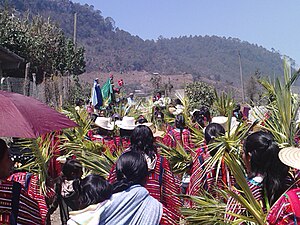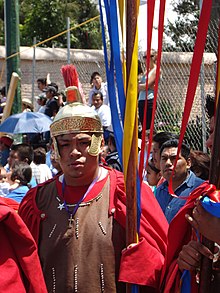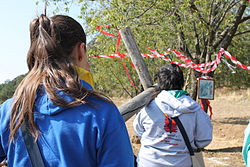Holy Week in Mexico
Mexico's Holy Week traditions are mostly based on those from Spain, brought over with the Spanish conquest of the Aztec Empire, but observances have developed variations in different parts of the country due to the evangelization process in the colonial period and indigenous influences.
[2][3] Mexican television features movies, documentaries and other shows focused on the religious event and other topics related to the Catholic faith, especially in Latin America.
As most events related to Holy Week occur outside and in large gatherings, antojitos (roughly translated as Mexican street food or snacks) is most associated with the holiday.
[5][7] On the Wednesday before Easter, a Mass called the “vespers of darkness” (los matines de la tinieblas) recalls the disciples’ abandonment of Jesus.
Many churches also hold reenactments of the Last Supper, but Masses usually omit the exchanges of greeting of peace as a reminder of Judas’ betrayal of Jesus.
[2][8] Reenactments of the day of crucifixion take place in almost all communities in Mexico on Good Friday and for a number these traditions extend to a passion play enacted most or all of Holy Week.
In major productions, hundreds of people participate including the entrance of Jesus into Jerusalem, the Last Supper, the Betrayal, the Judgment, the procession with the cross, the Crucifixion up to the Resurrection.
[2][6] Originally, it was the burning in effigy of the disciple that betrayed Jesus, a custom introduced to Mexico as part of the evangelization process.
[10] Mexico's Holy Week traditions are based on Spanish ones brought over during the Conquest, along with those created during the evangelization process with some indigenous influence.
This production involves over 4000 local residents (all of whom are born in Iztapalapa) whom perform scenes related to the last week of Jesus's life from Palm Sunday to Good Friday.
The play is not a strictly Biblical production as there are a number of characters such as a spy, a dog, a “wandering Jew” and others that are unique to this event.
He then carries a cross from this square to the Cerro de la Estrella on a route over a mile long through eight of the borough's oldest neighborhoods.
It begins on Palm Sunday, with a large wooden statue of Christ traveling on a donkey from the town of Tehuilotepec about four miles to the center of Taxco.
In these processions, Biblical figures related to the Passion of Christ are represented by wooden statues from the town and surrounding villages, carried on litters, accompanied by musical instruments playing melodies with pre-Hispanic influence.
The Encruzados carry a bundle of thorned blackberry canes of up to 100 pounds tied onto their shirtless back and arms with a candle in each hand.
On Good Friday, this image is carried to the parish church of San Miguel, accompanied by residents dressed as the disciples and Roman soldiers.
At noon, images of the Holy Family, the disciples, Mary Magdalene and John the Baptist are also in procession and a passion play is performed.
It begins at 8 pm at the Plaza del Carmen, with actors dressed as Roman troops playing drums and bugle.
They are joined by more as they move onto the streets, dressed in white robes with cone-shaped hoods with symbols denoting what religious group they belong to.
The procession continues around the town, punctuated by ritual speeches until midnight, when the last of the robed figures returns to the Carmen Church.
[13] In Tzintzuntzan for most of Holy Week, there are men on horseback, in red hoods and lavender robes, that patrol the area to make sure that stores or craftsmen are doing business as usual.
The focus of the pilgrimage is an image of a black, crucified Christ and the rites here are a mix of Christian and pre-Hispanic influences, such as bathers dipping into a fresh water spring for purification.
[21] In 2011 the Mexico City eastern bus terminal, TAPO, served 180,000 people per day during Holy Week, about double its normal volume.
[2] The most important vacation spots at this time are beach areas such as Acapulco, Cancún, Puerto Vallarta, Veracruz, Mazatlan, Los Cabos and Huatulco.
[21][23] Beach towns and other resorts fill with vacationers as well as street vendors and wandering musicians who take advantage of the business opportunity.






